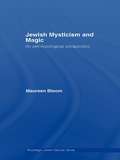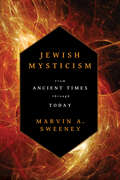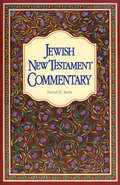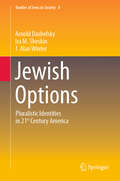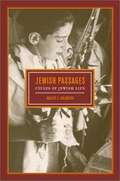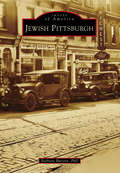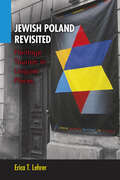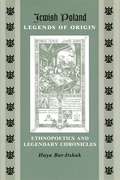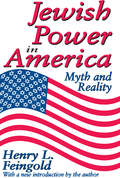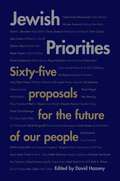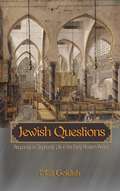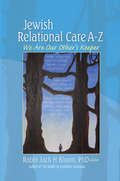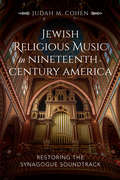- Table View
- List View
Jewish Mysticism and Magic: An Anthropological Perspective (Routledge Jewish Studies Series)
by Maureen BloomProviding a unique anthropological perspective on Jewish mysticism and magic, this book is a study of Jewish rites and rituals and how the analysis of early literature provides the roots for understanding religious practices. It includes analysis on the importance of sacrifice, amulets, and names, and their underlying cultural constructs and the persistence of their symbolic significance.
Jewish Mysticism: From Ancient Times through Today
by Marvin A. SweeneyQuestions of how the divine presence is understood and interacts within the world have been around since the time of the biblical prophets. The Jewish mystical tradition conceives God as active, just, powerful, and present while allowing for divine limitation so as to understand the relationship between G-d and the Jewish people in their history. Jewish Mysticism surveys Jewish visionary and mystical experience from biblical and ancient Near Eastern times through the modern period and the emergence of modern Hasidism. Marvin Sweeney provides a comprehensive treatment of one of the most dynamic fields of Jewish studies in the twenty-first century, providing an accessible overview of texts and interpretative issues. Sweeney begins with the biblical period, which most treatments of Jewish mysticism avoid, and includes chapters on the ancient Near East, the Pentateuch, the Former Prophets and Psalms, the Latter Prophets, Jewish Apocalyptic, the Heikhalot Literature, the Sefer Yetzirah and early Kabbalistic Literature, the Zohar, Lurianic Kabbalah and the Shabbetean Movement, and the Hasidic Movement. Placing Jewish apocalyptic literature into the larger development of ancient Jewish visionary and mystical experience, Sweeney fills gaps left by the important but outdated work of others in the field. Ideal for the scholar, student, or general reader, Jewish Mysticism provides readers with a fresh understanding of the particular challenges, problems, needs, and perspectives of Judaism throughout its history.
Jewish New Testament Commentary: A Companion Volume To The Jewish New Testament
by David H. SternDrawing on years of research, Dr. Stern relates the New Testament text to the Tanakh (Old Testament), to the historical setting, to rabbinic materials and Christian theology. He answers questions Jewish people have about Yeshua, the New Testament, and Christianity; questions Christians have about Judaism and the Jewish roots of their faith; and questions Messianic Jews have about being both Jewish and Messianic.
Jewish Noir: Contemporary Tales of Crime and Other Dark Deeds
by Kenneth WishniaA unique collection of all-new stories by award-winning authors. This anthology includes the work of numerous authors such as Marge Piercy, Harlan Ellison, S. J. Rozan, Nancy Richler, Moe Prager (Reed Farrel Coleman), Wendy Hornsby, Charles Ardai, and Kenneth Wishnia. The stories explore such issues as the Holocaust and its long-term effects on subsequent generations, anti-Semitism in the mid- and late-20th-century United States, and the dark side of the Diaspora (e.g., the decline of revolutionary fervor, the passing of generations, the Golden Ghetto, etc.). The stories in this collection include "Trajectories," Marge Piercy's story of the divergent paths taken by two young men from the slums of Cleveland and Detroit in a rapidly changing post–WW II society; "Some You Lose," Nancy Richler's empathetic exploration of the emotional and psychological challenges of trying to sum up a man's life in a eulogy; and "Yahrzeit Candle," Stephen Jay Schwartz's take on the subtle horrors of the inevitable passing of time. These works include many "teachable moments" about the history of prejudice, the contradictions of ethnic identity, and assimilation into American society and culture.
Jewish Options: Pluralistic Identities in 21st Century America (Studies of Jews in Society #8)
by Arnold Dashefsky Ira M. Sheskin J.Alan WinterThis book offers an examination of an expanding set of options for being Jewish in contemporary American society. It examines the evolution of Jewish identity across five epochs of Jewish civilization as well as the transformation of the American Jewish experience across four centuries. In addition, an institutional history and a geographic, demographic, and religious profile of American Jews are presented, including an outline of contemporary Jewish options to express Jewish identity in twenty-first century America. Readers will gain an understanding of how these options developed via the provision of a socio-historical and a social scientific analysis of each option in one integrated volume. The book also discusses contemporary challenges to the continuity of American Jewish community and identity including the issues of education, interfaith marriage, and philanthropy.
Jewish Passages: Cycles of Jewish Life
by Harvey E. GoldbergThis book is both comprehensive and accessible, making Jewish customs meaningful even to non-specialists. A scholarly achievement with tremendous value for anyone in Jewish Studies including rabbis and members of synagogue study groups.
Jewish Pasts, German Fictions: History, Memory, and Minority Culture in Germany, 1824-1955
by Jonathan SkolnikJewish Pasts, German Fictions is the first comprehensive study of how German-Jewish writers used images from the Spanish-Jewish past to define their place in German culture and society. Jonathan Skolnik argues that Jewish historical fiction was a form of cultural memory that functioned as a parallel to the modern, demythologizing project of secular Jewish history writing. What did it imply for a minority to imagine its history in the majority language? Skolnik makes the case that the answer lies in the creation of a German-Jewish minority culture in which historical fiction played a central role. After Hitler's rise to power in 1933, Jewish writers and artists, both in Nazi Germany and in exile, employed images from the Sephardic past to grapple with the nature of fascism, the predicament of exile, and the destruction of European Jewry in the Holocaust. The book goes on to show that this past not only helped Jews to make sense of the nonsense, but served also as a window into the hopes for integration and fears about assimilation that preoccupied German-Jewish writers throughout most of the nineteenth century. Ultimately, Skolnik positions the Jewish embrace of German culture not as an act of assimilation but rather a reinvention of Jewish identity and historical memory.
Jewish Peoplehood
by Noam PiankoAlthough fewer American Jews today describe themselves as religious, they overwhelmingly report a strong sense of belonging to the Jewish people. Indeed, Jewish peoplehood has eclipsed religion--as well as ethnicity and nationality--as the essence of what binds Jews around the globe to one another. In Jewish Peoplehood, Noam Pianko highlights the current significance and future relevance of "peoplehood" by tracing the rise, transformation, and return of this novel term. The book tells the surprising story of peoplehood. Though it evokes a sense of timelessness, the term actually emerged in the United States in the 1930s, where it was introduced by American Jewish leaders, most notably Rabbi Stephen Wise and Rabbi Mordecai Kaplan, with close ties to the Zionist movement. It engendered a sense of unity that transcended religious differences, cultural practices, geographic distance, economic disparity, and political divides, fostering solidarity with other Jews facing common existential threats, including the Holocaust, and establishing a closer connection to the Jewish homeland. But today, Pianko points out, as globalization erodes the dominance of nationalism in shaping collective identity, Jewish peoplehood risks becoming an outdated paradigm. He explains why popular models of peoplehood fail to address emerging conceptions of ethnicity, nationalism, and race, and he concludes with a much-needed roadmap for a radical reconfiguration of Jewish collectivity in an increasingly global era. Innovative and provocative, Jewish Peoplehood provides fascinating insight into a term that assumes an increasingly important position at the heart of American Jewish and Israeli life.
Jewish Perspectives on Theology and the Human Experience of Disability
by Judith Z. Abrams William C. GaventaFew people are untouched by the issue of disability, whether personally or through a friend or relative. Jewish Perspectives on Theology and the Human Experience of Disability shares moving insights from around the world and across the broad spectrum of Judaism on how and why the Jewish community is incomplete without the presence and participation of the disabled. Authors representing each of the three main movements of Judaism--Orthodox, Conservative, and Reform--examine theology, scripture, ethics, practical theology, religious education, and personal experience to understand and apply the lessons and wisdom of the past to issues of the present.
Jewish Perspectives on Theology and the Human Experience of Disability
by William GaventaA re-examination of Jewish scripture and teachings about disabilitiesFew people are untouched by the issue of disability, whether personally or through a friend or relative. Jewish Perspectives on Theology and the Human Experience of Disability shares moving insights from around the world and across the broad spectrum of Judaism on how and why the Jewish community is incomplete without the presence and participation of the disabled. Authors representing each of the three main movements of Judaism-Orthodox, Conservative, and Reform-examine theology, scripture, ethics, practical theology, religious education, and personal experience to understand and apply the lessons and wisdom of the past to issues of the present.Authors from Israel, the United States, the United Kingdom, and Australia reflect on their theological understandings of specific disabilities and on disability as a whole. Jewish Perspectives on Theology and the Human Experience of Disability re-examines tradition, teachings, and beliefs to shatter stereotypes of Judaism and common interpretations of scripture. This unique book addresses several disabilities (blindness, deafness, intellectual disabilities, autism, learning disabilities), and a wide range of topics, including human rights and disabilities, Jewish laws concerning niddah, misconceptions about disabilities in the Hebrew Bible, Jewish community programs to include people with disabilities, and the need to educate American Jews about Jewish genetic diseases.Jewish Perspectives on Theology and the Human Experience of Disability examines: three methods that allow Jews who are blind to participate in the Torah service the spiritual needs of people with learning disabilities the attitude of Jewish Law toward marriage and parenthood on people with intellectual disabilities how the rabbis of the Mishnah incorporated Greco-Roman beliefs about the connections between hearing, speech, and intelligence into Jewish law a sampling of opinions issued on matters concerning disabilities by the Responsa Committee of the Central Conference of American Rabbis how the Jewish sages have made participation by people with disabilities possible and much moreJewish Perspectives on Theology and the Human Experience of Disability also includes reviews of Judaism and Disability: Portrayals in Ancient Texts from the Tanach through the Bavil and Disability in Jewish Law, as well as comprehensive resource collections. This book is an essential read for clergy and lay leaders involved in the support of people with disabilities, for the families of people with disabilities, and for anyone working with the disabled.
Jewish Phenomenon: Seven Keys to the Enduring Wealth of a People
by Steven SilbigerSpielberg, Brin, Dell, Seinfeld—phenomenally successful . . . and Jewish.Why have Jews risen to the top of the business and professional world in numbers staggeringly out of proportion to their percentage of the American population? Steven Silbiger has the answer. Based on the author''s synthesis of wide reading and research, The Jewish Phenomenon sets forth seven principles that form the bedrock of Jewish financial success.With startling statistics, a wealth of anecdotes, and the fascinating details behind some of America''s biggest business success stories, Silbiger convincingly shows how these seven keys have helped the Jews historically and how they continue to ensure Jewish success today. More important, the author makes clear that these principles are equally at the disposal of Jews and non-Jews alike. The amazing success of the Jews simply proves that they work.The Jewish Phenomenon pays tribute not merely to the success of a people but to the commonsense wisdom and enduring values that can enrich us all.
Jewish Philosophy And The Crisis Of Modernity: Essays And Lectures In Modern Jewish Thought
by Leo Strauss Kenneth Hart GreenExplores the impact on Jews and Judaism of the crisis of modernity, analyzing modern Jewish dilemmas and providing a prescription for their resolution.
Jewish Philosophy as a Guide to Life: Rosenzweig, Buber, Levinas, Wittgenstein (The\helen And Martin Schwartz Lectures In Jewish Studies)
by Hilary PutnamAn &“engagingly personal&” exploration of Rosenzweig, Buber, Levinas, and the relationship between philosophy and religion (Times Literary Supplement). In this book, distinguished philosopher and practicing Jew Hilary Putnam questions the thought of three major Jewish philosophers of the twentieth century—Franz Rosenzweig, Martin Buber, and Emmanuel Levinas—to help him reconcile the philosophical and religious sides of his life. An additional presence in the book is Ludwig Wittgenstein, who, although not a practicing Jew, thought about religion in ways that Putnam juxtaposes to the views of Rosenzweig, Buber, and Levinas. Putnam explains the leading ideas of each of these great thinkers, bringing out what, in his opinion, constitutes the decisive intellectual and spiritual contributions of each of them. Although the religion discussed is Judaism, the depth and originality of these philosophers, as incisively interpreted by Putnam, make their thought nothing less than a guide to life.&“One of the most distinguished analytical philosophers, Putnam has written an unusual book that uses the thought of key philosophers to find points of commonality between the religious and the philosophical.&” —Library Journal
Jewish Pittsburgh (Images of America)
by Barbara BurstinBy the mid-19th century, Jews from German lands began settling in Pittsburgh, later to be followed by Jews from the Russian and Austro-Hungarian Empires and Romania. They founded businesses and organizations such as Giant Eagle, Kaufmann's Department Store, Montefiore Hospital, the Pittsburgh Playhouse, the Civic Light Opera, and the Pittsburgh Pirates. Sophie Masloff became the first woman and the first Jew to serve as mayor, and civic reformer and lawyer A. Leo Weil, philanthropist Leon Falk Jr., and social justice crusader Florence Reizenstein all had schools named after them. From Allegheny City and "the Hill" to Squirrel Hill and the East End, the Jewish population preserved its distinct core community and contributed to its adopted city in multiple ways. Today, it numbers more than 40,000, and their story is one of grit, determination, risk taking, hard knocks, and no small measure of success.
Jewish Poland Revisited: Heritage Tourism In Unquiet Places (New Anthropologies of Europe)
by Erica T. LehrerSince the end of Communism, Jews from around the world have visited Poland to tour Holocaust-related sites. A few venture further, seeking to learn about their own Polish roots and connect with contemporary Poles. For their part, a growing number of Poles are fascinated by all things Jewish. Erica T. Lehrer explores the intersection of Polish and Jewish memory projects in the historically Jewish neighborhood of Kazimierz in Krakow. Her own journey becomes part of the story as she demonstrates that Jews and Poles use spaces, institutions, interpersonal exchanges, and cultural representations to make sense of their historical inheritances.
Jewish Poland—Legends of Origin: Ethnopoetics and Legendary Chronicles (Raphael Patai Series in Jewish Folklore and Anthropology)
by Haya Bar-ItzhakThe first appearance of Jews in Poland and their adventures during their early years of settlement in the country are concealed in undocumented shadows of history. What survived are legends of origin that early chroniclers, historians, writers, and folklore scholars transcribed, thus contributing to their preservation. According to the legendary chronicles Jews resided in Poland for a millennium and developed a vibrant community. <P><P> Haya Bar-Itzhak examines the legends of origin of the Jews of Poland and discloses how the community creates its own chronicle, how it structures and consolidates its identity through stories about its founding, and how this identity varies from age to age. Bar-Itzhak also examines what happened to these legends after the extermination of Polish Jewry during the Holocaust, when the human space they describe no longer exists except in memory. For the Polish Jews after the Holocaust, the legends of origin undergo a fascinating transformation into legends of destruction. <P><P> Jewish Poland-Legends of Origin brings to light the more obscure legends of origin as well as those already well known. This book will be of interest to scholars in folklore studies as well as to scholars of Judaic history and culture.
Jewish Population and Identity: Concept and Reality (Studies of Jews in Society #1)
by Uzi Rebhun Sergio DellaPergolaThis book examines the fundamentals of Jewish demography and sociology around the world. It is not only concerned with documenting patterns of population change but also with an intriguing and ever-present issue like "Who is a Jew?" The latter transcends the limits of quantitative assessment and deeply delves into the nature, boundaries, and quality of group identification. A growing challenge is how to bridge between concept – related to ideals and theory – and reality – reflecting field research. Divided into six sections, the book discusses historical demography, immigration and settlement, population dynamics, social stratification and economy, family and Jewish identity in the U.S., and Jewish identity in Israel. The volume represents the dynamic and diverse nature of the study of world and local Jewish populations. It shows how that field of study provides an important contribution to the broader and now rapidly expanding study of religious and ethnic groups. Scholars in disciplines such as history, geography, sociology, economics, political science, and especially demography follow and analyze the social and cultural patterns of Jews in different places around the globe, at various times, and from complementary perspectives. They make use of historical sources that have recently become accessible, utilize new censuses and surveys, and adopt advanced analytical methods. While some of their observations attest to consistency in the Jews’ demographic and identificational patterns, others evolve and ramify in new directions that reflect general processes in the areas and societies that Jews inhabit, internal changes within Jewish communities, and intergenerational trends in personal preferences of religious and ethnic orientations. This volume brings together contributions from scholars around the world and presents new and updated research and insights.
Jewish Power in America: Myth and Reality
by Henry FeingoldJewish political power exists as a separate agency in the American polity, but before it can be determined whether it is inordinate, historian Henry L. Feingold declares that it first needs to be identified and defined. Jewish power is not associated with military armaments as with a sovereign state like Israel. Nor is it personal power. There are many influential Jews today who have raised huge sums for office seekers, but there are none whose use of financial resources was inordinate. With the exception of an abiding concern with the security of Israel, there are no overriding public policy concerns that differentiate Jewish voters from the informed, educated segment of the American electorate.Feingold acknowledges that American Jews do have political power. But what kind is it, and how does it compare to the power exercised by other ethnic and interest groups that thrive in the American polity? The basic charge of those who have raised the alarm about Jewish power—that it is used conspiratorially against the national interest—is addressed and repudiated. This book addresses the question of Jewish power by examining five recent major instances, beginning with the New Deal, when the play of Jewish power, or power exercised by Jews, was evident.The engagement of American Jewry in the political process is amply documented by survey research and evidenced by the disproportionate number of Jewish office holders on all levels of government. It can be traced in some measure to its relationship to European Jewish migration and to the inherent activism of the political left. The work presents the reader with a broadly comprehensive and highly informative picture of American Jewish participation in the American polity.
Jewish Pride
by Michael SteinhardtMichael Steinhardt left a stellar career on Wall Street and spent the next three decades launching revolutionary philanthropic programs like Birthright Israel and OneTable that offer a proud, rich future for the next generation of secular American Jews.What are the keys to a proud Jewish life? Part memoir, part manifesto, Michael Steinhardt&’s Jewish Pride offers a compelling vision for a rich, rewarding future for Jews in America and around the world. From his middle class beginnings in Brooklyn to a spectacular Wall Street career, Steinhardt understood that apathy and assimilation were threatening the Jewish future in America. Meanwhile established Jewish institutions were failing in the urgent task of strengthening secular Jewish identity. Using his own capital and the wisdom and connections he&’d gained in his successful business career, Steinhardt recruited partners, focused on data and results, and even got the Israeli government to help launch the revolutionary Birthright program. By turns provocative, inspiring, revealing, and outright hilarious, Jewish Pride captures its author&’s unique personality and outlook and offers honest talk about the Jewish world today, along with a bold prescription for revitalizing Jewish life in the future.
Jewish Priorities: Sixty-Five Proposals for the Future of Our People
by David HazonyAn unprecedented, large-scale collection of timely and provocative essays from a wide range of Jewish thought leaders that aims to start a global conversation among Jews about their future as a people.&“…a mind-expanding look at how Judaism can survive and thrive in the 21st century.&” –Publishers Weekly Imagine having the entire Jewish people over for dinner—and hosting a raucous, creative, riveting debate about their collective future. Jewish Priorities offers, for the first time, a wide-ranging, ambitious, and genuinely &“pan-Jewish&” conversation. Encompassing more than sixty top authors from around the Jewish world—Israelis and Diaspora writers; younger influencers and veteran opinion leaders; rabbinic and communal leaders, journalists and scholars, and literary and cultural figures, ranging from secular to ultra-Orthodox—each contributor offers a different priority for the Jewish people. In the process, Jewish Priorities captures the tremendous breadth, depth, and passionate commitment that has long defined this unique community in history. These essays are all original and come from some of our greatest luminaries—thought leaders like Natan Sharansky, Dara Horn, Yossi Klein Halevi, Ruth Wisse, Shaul Magid, David Wolpe, Fania Oz-Salzberger, and many more. Their topics vary widely, from Zionism and antisemitism to education and philanthropy; from the Holocaust to Jewish intimacy; from the quest for God to the failure of Jewish institutions, to the best way to study the Torah in an age of viral videos. Jewish Priorities offers an unprecedented snapshot of the cultural, political, and religious currents driving an entire generation of Jews—but also the deepest aspirations and dreams of this beautiful, unique people at a pivotal moment in our history.
Jewish Questions: Responsa on Sephardic Life in the Early Modern Period
by Matt GoldishIn Jewish Questions, Matt Goldish introduces English readers to the history and culture of the Sephardic dispersion through an exploration of forty-three responsa--questions about Jewish law that Jews asked leading rabbis, and the rabbis' responses. The questions along with their rabbinical decisions examine all aspects of Jewish life, including business, family, religious issues, and relations between Jews and non-Jews. Taken together, the responsa constitute an extremely rich source of information about the everyday lives of Sephardic Jews. The book looks at questions asked between 1492--when the Jews were expelled from Spain--and 1750. Originating from all over the Sephardic world, the responsa discuss such diverse topics as the rules of conduct for Ottoman Jewish sea traders, the trials of an ex-husband accused of a robbery, and the rights of a sexually abused wife. Goldish provides a sizeable introduction to the history of the Sephardic diaspora and the nature of responsa literature, as well as a bibliography, historical background for each question, and short biographies of the rabbis involved. Including cases from well-known communities such as Venice, Istanbul, and Saloniki, and lesser-known Jewish enclaves such as Kastoria, Ragusa, and Nablus, Jewish Questions provides a sense of how Sephardic communities were organized, how Jews related to their neighbors, what problems threatened them and their families, and how they understood their relationship to God and the Jewish people.
Jewish Radical Ultra-Orthodoxy Confronts Modernity, Zionism and Women’s Equality
by Motti Inbari Inbari, Motti and Vardi, Shaul Shaul VardiIn Jewish Radical Ultra-Orthodoxy Confronts Modernity, Zionism and Women's Equality, Motti Inbari undertakes a study of the culture and leadership of Jewish radical ultra-Orthodoxy in Hungary, Jerusalem and New York. He reviews the history, ideology and gender relations of prominent ultra-Orthodox leaders Amram Blau (1894–1974), founder of the anti-Zionist Jerusalemite Neturei Karta, and Yoel Teitelbaum (1887–1979), head of the Satmar Hasidic movement in New York. Focussing on the rabbis' biographies, the author analyzes their enclave building methods, their attitude to women and modesty, and their eschatological perspectives. The research is based on newly discovered archival materials, covering many unique and remarkable findings. The author concludes with a discussion of contemporary trends in Jewish religious radicalization. Inbari highlights the resilience of the current generations' sense of community cohesion and their capacity to adapt and overcome challenges such as rehabilitation into potentially hostile secular societies.
Jewish Relational Care A-Z: We Are Our Other's Keeper
by Jack H BloomA collection of caregiving tools combining the values of Jewish tradition and self-relations-useful for practitioners of ANY faith!Self-relations, a powerful framework for doing respectful and humane caregiving for oneself and for others is here brought into relationship with Jewish thought. Jewish Relational Care A-Z: We Are Our Other&’s Keeper is an extensive resource for caregiving tools and approaches. Using Jewish tradition and Self-Relations as take-off points, experts from many fields provide insightful perspectives and effective strategies for caregiving.In the language of self-relations each of us is not referred to as a Self. Instead, each of us is more accurately described as a relationship between "selves"-relationship is the basic psychological and religious unit! Jewish Relational Care A-Z: We Are Our Other&’s Keeper sensitively centers on relationships and the healing process, using the understanding that to spark healing in others, a loving, respectful relationship must first be present between every aspect of our "selves." Thirty-six categories of caregiving are comprehensively presented, allowing its use as a helpful resource for any clergy considering any of the included topics. Each author&’s personal reflections, and personal experiences using care tools clearly illustrate how love-respect relationships within oneself can transcend into effective care for others.Jewish Relational Care A-Z: We Are Our Other&’s Keeper provides helpful tools and explores: the use of language as a relational care tool time management for optimum performance for oneself and for others compassion fatigue, the need for self-care, and nurturing your own spiritual and psychological development purposeful visiting as a sacred task silence as an important part of spiritual care the profound difference made in lives through relational listening music as sacred power-a communion between humans and the Divine chanting as an intimate expression of the soul creative ritual in relational healing spontaneous prayer, and its place in relational care relational care with other faiths inside and outside of the community care for those going through divorce care when a pregnancy is unwelcome relational care for sexual orientation and gender identity issues successful caring for those who don&’t care about you dealing with traumatic loss care for those who have sinned sexually fragile relationships care with the healthy aging relational care and retired clergy care for those traumatized by sexual abuse care for the cognitively impaired, mentally ill, and developmentally disabled care for the final moments of life care for the sick and dying care within the grieving processJewish Relational Care A-Z: We Are Our Other&’s Keeper is practical, insightful reading for clergy and caregivers of all denominations, educators, students, and lay people who care about clergy and their work.
Jewish Religious Conflicts (Routledge Revivals)
by Maurice SimonFirst published in 1950, Jewish Religious Conflicts gives an account of the principal cleavages that have taken place within the Jewish people since the close of the Old Testament over questions of religious faith, doctrine and practice. While passing in review the chief sects that have formed themselves during that period, it pays particular attention to the most recent cleavages, those between the ‘orthodox’ and ‘reform’, and between the ‘conservative’ and ‘liberal’ movements, which are dividing the Jewish community. This book will be of interest to students of religion and history.
Jewish Religious Music in Nineteenth-Century America: Restoring the Synagogue Soundtrack
by Judah M. CohenThis study of synagogue music in the United States in the second half of the nineteenth century “sets a high standard for historical musicology” (Musica Judaica).In Jewish Religious Music in Nineteenth-Century America: Restoring the Synagogue Soundtrack, Judah M. Cohen demonstrates that Jews constructed a robust religious musical conversation in the United States during the mid- to late-nineteenth century. While previous studies of American Jewish music history have looked to Europe as a source of innovation during this time, Cohen’s careful analysis of primary archival sources tells a different story. Far from seeing a fallow musical landscape, Cohen finds that Central European Jews in the United States spearheaded a major revision of the sounds and traditions of synagogue music during this period of rapid liturgical change.Focusing on the influences of both individuals and texts, Cohen demonstrates how American Jewish musicians sought to balance artistry and group singing, rather than “progressing” from solo chant to choir and organ. Congregations shifted between musical genres and practices during this period in response to such factors as finances, personnel, and communal cohesiveness. Cohen concludes that the “soundtrack” of nineteenth-century Jewish American music heavily shapes how we look at Jewish American music and life in the first part of the twenty-first century, arguing that how we see, and especially hear, history plays a key role in our understanding of the contemporary world around us. Supplemented with an interactive website that includes the primary source materials, recordings of the music discussed, and a map that highlights the movement of key individuals, Cohen’s research defines more clearly the sound of nineteenth-century American Jewry.
